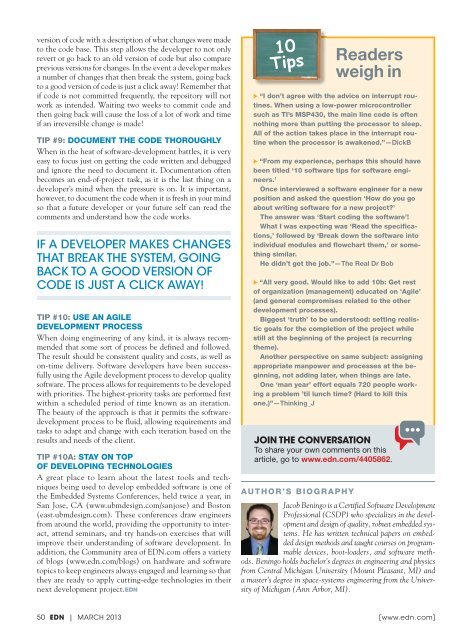201303.pdf 36567KB Mar 22 2013 09:11:22 PM
201303.pdf 36567KB Mar 22 2013 09:11:22 PM
201303.pdf 36567KB Mar 22 2013 09:11:22 PM
You also want an ePaper? Increase the reach of your titles
YUMPU automatically turns print PDFs into web optimized ePapers that Google loves.
version of code with a description of what changes were made<br />
to the code base. This step allows the developer to not only<br />
revert or go back to an old version of code but also compare<br />
previous versions for changes. In the event a developer makes<br />
a number of changes that then break the system, going back<br />
to a good version of code is just a click away! Remember that<br />
if code is not committed frequently, the repository will not<br />
work as intended. Waiting two weeks to commit code and<br />
then going back will cause the loss of a lot of work and time<br />
if an irreversible change is made!<br />
TIP #9: DOCUMENT THE CODE THOROUGHLY<br />
When in the heat of software-development battles, it is very<br />
easy to focus just on getting the code written and debugged<br />
and ignore the need to document it. Documentation often<br />
becomes an end-of-project task, as it is the last thing on a<br />
developer’s mind when the pressure is on. It is important,<br />
however, to document the code when it is fresh in your mind<br />
so that a future developer or your future self can read the<br />
comments and understand how the code works.<br />
IF A DEVELOPER MAKES CHANGES<br />
THAT BREAK THE SYSTEM, GOING<br />
BACK TO A GOOD VERSION OF<br />
CODE IS JUST A CLICK AWAY!<br />
TIP #10: USE AN AGILE<br />
DEVELO<strong>PM</strong>ENT PROCESS<br />
When doing engineering of any kind, it is always recommended<br />
that some sort of process be defined and followed.<br />
The result should be consistent quality and costs, as well as<br />
on-time delivery. Software developers have been successfully<br />
using the Agile development process to develop quality<br />
software. The process allows for requirements to be developed<br />
with priorities. The highest-priority tasks are performed first<br />
within a scheduled period of time known as an iteration.<br />
The beauty of the approach is that it permits the softwaredevelopment<br />
process to be fluid, allowing requirements and<br />
tasks to adapt and change with each iteration based on the<br />
results and needs of the client.<br />
TIP #10A: STAY ON TOP<br />
OF DEVELOPING TECHNOLOGIES<br />
A great place to learn about the latest tools and techniques<br />
being used to develop embedded software is one of<br />
the Embedded Systems Conferences, held twice a year, in<br />
San Jose, CA (www.ubmdesign.com/sanjose) and Boston<br />
(east.ubmdesign.com). These conferences draw engineers<br />
from around the world, providing the opportunity to interact,<br />
attend seminars, and try hands-on exercises that will<br />
improve their understanding of software development. In<br />
addition, the Community area of EDN.com offers a variety<br />
of blogs (www.edn.com/blogs) on hardware and software<br />
topics to keep engineers always engaged and learning so that<br />
they are ready to apply cutting-edge technologies in their<br />
next development project.EDN<br />
10<br />
Tips<br />
▶ “I don’t agree with the advice on interrupt routines.<br />
When using a low-power microcontroller<br />
such as TI’s MSP430, the main line code is often<br />
nothing more than putting the processor to sleep.<br />
All of the action takes place in the interrupt routine<br />
when the processor is awakened.”—DickB<br />
▶ “From my experience, perhaps this should have<br />
LIKE THIS?<br />
been titled ‘10 software tips for software engineers.’<br />
For more from Jacob Beningo,<br />
Once interviewed see his a software Embedded engineer Basics for blog a new<br />
position and asked at www.edn.com/<br />
the question ‘How do you go<br />
about writing software electronics-blogs/4375394.<br />
for a new project?’<br />
The answer was ‘Start coding the software’!<br />
What I was expecting was ‘Read the specifications,’<br />
followed by ‘Break down the software into<br />
individual modules and flowchart them,’ or something<br />
similar.<br />
He didn’t get the job.”—The Real Dr Bob<br />
▶ “All very good. Would like to add 10b: Get rest<br />
of organization (management) educated on ‘Agile’<br />
(and general compromises related to the other<br />
development processes).<br />
Biggest ‘truth’ to be understood: setting realistic<br />
goals for the completion of the project while<br />
still at the beginning of the project (a recurring<br />
theme).<br />
Another perspective on same subject: assigning<br />
appropriate manpower and processes at the beginning,<br />
not adding later, when things are late.<br />
One ‘man year’ effort equals 720 people working<br />
a problem ’til lunch time? (Hard to kill this<br />
one.)”—Thinking_J<br />
AUTHOR’S BIOGRAPHY<br />
Readers<br />
weigh in<br />
JOIN THE CONVERSATION<br />
To share your own comments on this<br />
article, go to www.edn.com/4405862.<br />
Jacob Beningo is a Certified Software Development<br />
Professional (CSDP) who specializes in the development<br />
and design of quality, robust embedded systems.<br />
He has written technical papers on embedded<br />
design methods and taught courses on programmable<br />
devices, boot-loaders, and software methods.<br />
Beningo holds bachelor’s degrees in engineering and physics<br />
from Central Michigan University (Mount Pleasant, MI) and<br />
a master’s degree in space-systems engineering from the University<br />
of Michigan (Ann Arbor, MI).<br />
50 EDN | MARCH <strong>2013</strong> [ www.edn.com ]






![[270].pdf 37407KB Sep 02 2010 09:55:57 AM - ElectronicsAndBooks](https://img.yumpu.com/50350834/1/185x260/270pdf-37407kb-sep-02-2010-095557-am-electronicsandbooks.jpg?quality=85)
![draaien, A Viruly 1935 OCR c20130324 [320]. - ElectronicsAndBooks](https://img.yumpu.com/49957773/1/190x252/draaien-a-viruly-1935-ocr-c20130324-320-electronicsandbooks.jpg?quality=85)



![20051110 c20051031 [105].pdf 35001KB Feb 18 2009 08:46:32 PM](https://img.yumpu.com/48687202/1/190x253/20051110-c20051031-105pdf-35001kb-feb-18-2009-084632-pm.jpg?quality=85)





